Zoom
Trash

Minnesota Mexican's Modern Family. This is part of our Hispanic Heritage Month series, "Our Latino Heritage" where we are profiling a U.S.

Hispanic from each of our Spanish-speaking Latin American and Caribbean homelands. Ana Pottratz came to the United States from her native Mexico as a well-to-do 20-year old with no plans to stay. "I was a trained teacher in Monterrey and my goal was to be able to teach in a bilingual school, which paid more, so I came to the U.S. to live with an American family for one year to increase my English language skills," Pottratz said. Young immigrant's journey leads to permission to stay. Listen Irma Marquez talks to MPR's Tom Crann Dec 14, 2012 Lea este articulo en español The rustling thud of mail hitting the mailbox sends Irma Marquez on a beeline for the door of her mom's home in this southern Minnesota city.
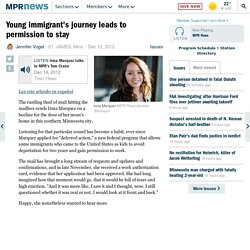
Listening for that particular sound has become a habit, ever since Marquez applied for "deferred action," a new federal program that allows some immigrants who came to the United States as kids to avoid deportation for two years and gain permission to work. The mail has brought a long stream of requests and updates and confirmations, and in late November, she received a work authorization card, evidence that her application had been approved. She had long imagined how that moment would go, that it would be full of tears and high emotion.
Happy, she nonetheless wanted to hear more. When Marquez applied for deferred action last summer, just two days after the program began accepting applications, she mailed in a thick stack of documents. A Mexican immigrant speaks his truth about being a Hispanic Minnesotan. In WalletHub's 2015 study of "States Where Hispanics Are Most Assimilated," the Land of 10,000 Lakes found itself well in the bottom half of such metrics as median annual income (41st at less than $20,000), homeownership rates (45th with about one in three Hispanics owning a home), and dead last in the 50th spot in public high school graduation rate.
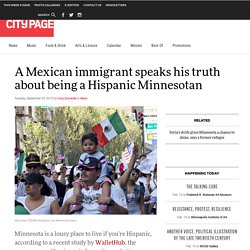
A little more than 250,000 Hispanics call Minnesota home — or roughly 5 percent of the state's 5.5 million population. Almost two-thirds are of Mexican origin. According to the Pew Research Center, a third of Minnesota's Hispanic population age 17 and younger live in poverty, while three out of every ten have no health insurance. Pedro Lopez, 40, personifies the modern American Dream.
He came here 25 years ago as a foreign exchange student from central Mexico. Worthington, Minn., was dying. Then, enter the immigrants. – Twin Cities. WORTHINGTON, Minn. – Worthington is a small town with a big secret.
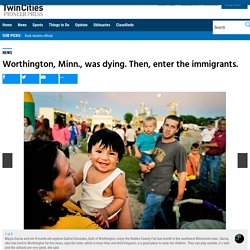
The farm county seat has comparably low crime and enviously low unemployment. Instead of tumbleweeds, its downtown strip has plenty of traffic and only two vacant storefronts. The biggest dance club and sole bakery have new owners. What’s not a secret is that more than a third of the town’s residents – 35 percent, by the last census count – are Hispanic.
City officials still think that’s an undercount. The trend didn’t happen in an instant: 30 years ago, many feared the southwest Minnesota town would become a ghost town. “How many rural markets are having an increase in babies being born? Minnesotanos: Latino Journeys in Minnesota. Since the early 1900s, Latinos have been a productive and essential part of Minnesota.
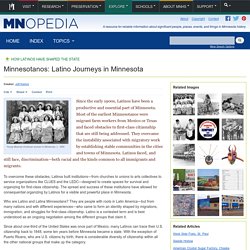
Most of the earliest Minnesotanos were migrant farm workers from Mexico or Texas and faced obstacles to first-class citizenship that are still being addressed. They overcame the instability associated with migratory work by establishing stable communities in the cities and towns of Minnesota. Latinos faced, and still face, discrimination—both racial and the kinds common to all immigrants and migrants. To overcome these obstacles, Latinos built institutions—from churches to unions to arts collectives to service organizations like CLUES and the LEDC—designed to create spaces for survival and organizing for first-class citizenship. Being Latino in Minnesota. St.

Paul, Minnesota, USA — Event goers head home, passing one of the many murals in the District del Sol, a neighborhood located on St. Paul’s West Side. Staying for my son. By Dymanh Chhoun, University of Minnesota, Class of 2011 Lina Marulanda Photo By: Dymanh Chhoun What I miss most is my family.
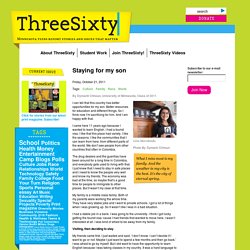
And the weather in my city is the best. It’s the city of eternal spring. I can tell that this country has better opportunities for my son. I came here 11 years ago because I wanted to learn English. Transcript of Thiago Heilman Brazil. Transcript of Ederick Lokpez Venezuela. Transcript Lina Ibarra Colombia. In Minnesota, a Community of Mexican Immigrants Takes Root. Saint Paul Historical. People of Mexican origin or descent began to come to St.
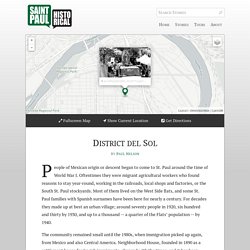
Paul around the time of World War I. Oftentimes they were migrant agricultural workers who found reasons to stay year-round, working in the railroads, local shops and factories, or the South St. Paul stockyards. Most of them lived on the West Side flats, and some St. Paul families with Spanish surnames have been here for nearly a century. The community remained small until the 1980s, when immigration picked up again, from Mexico and also Central America. Two commercial establishments, the restaurant Boca Chica (the Frias family, 1964) and the grocery, El Burrito Market (the Silva family, 1979), have been St. Cinco de Mayo, a holiday celebrated more in the United States than in Mexico, commemorates the 1863 Battle of Puebla, in which Mexican forces defeated the French.
Images Cite this Page: Paul Nelson, “District del Sol,” Saint Paul Historical, accessed February 15, 2017, Related Tours West Side: The Flats Subjects West Side Tags.